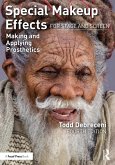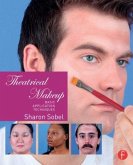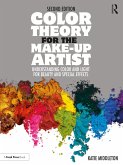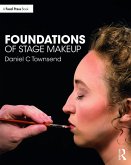- Broschiertes Buch
- Merkliste
- Auf die Merkliste
- Bewerten Bewerten
- Teilen
- Produkt teilen
- Produkterinnerung
- Produkterinnerung
Wig Making and Styling: A Complete Guide for Theatre and Film, Second Edition is the one-stop shop for the knowledge and skills you need to create and style wigs.
Andere Kunden interessierten sich auch für
![Historical Wig Styling: Ancient Egypt to the 1830s Historical Wig Styling: Ancient Egypt to the 1830s]() Allison Lowery (Wig and Austin Performing Arts C Makeup SpecialistHistorical Wig Styling: Ancient Egypt to the 1830s57,99 €
Allison Lowery (Wig and Austin Performing Arts C Makeup SpecialistHistorical Wig Styling: Ancient Egypt to the 1830s57,99 €![Special Makeup Effects for Stage and Screen Special Makeup Effects for Stage and Screen]() Todd DebreceniSpecial Makeup Effects for Stage and Screen73,99 €
Todd DebreceniSpecial Makeup Effects for Stage and Screen73,99 €![Theatrical Makeup Theatrical Makeup]() Sharon Sobel (Professor of Theatre and University o Costume DesignTheatrical Makeup57,99 €
Sharon Sobel (Professor of Theatre and University o Costume DesignTheatrical Makeup57,99 €![Color Theory for the Make-up Artist Color Theory for the Make-up Artist]() Katie Middleton (Freelance Makeup Artist, Los Angeles, CA)Color Theory for the Make-up Artist39,99 €
Katie Middleton (Freelance Makeup Artist, Los Angeles, CA)Color Theory for the Make-up Artist39,99 €![A Beginner's Guide to Special Makeup Effects A Beginner's Guide to Special Makeup Effects]() Christopher PayneA Beginner's Guide to Special Makeup Effects51,99 €
Christopher PayneA Beginner's Guide to Special Makeup Effects51,99 €![The Hair Stylist Handbook The Hair Stylist Handbook]() Gretchen Davis (Freelance Makeup Artist and USA Writer)The Hair Stylist Handbook66,99 €
Gretchen Davis (Freelance Makeup Artist and USA Writer)The Hair Stylist Handbook66,99 €![Foundations of Stage Makeup Foundations of Stage Makeup]() Daniel C TownsendFoundations of Stage Makeup40,99 €
Daniel C TownsendFoundations of Stage Makeup40,99 €-
-
-
Wig Making and Styling: A Complete Guide for Theatre and Film, Second Edition is the one-stop shop for the knowledge and skills you need to create and style wigs.
Hinweis: Dieser Artikel kann nur an eine deutsche Lieferadresse ausgeliefert werden.
Hinweis: Dieser Artikel kann nur an eine deutsche Lieferadresse ausgeliefert werden.
Produktdetails
- Produktdetails
- Verlag: Taylor & Francis Ltd
- 2 ed
- Seitenzahl: 336
- Erscheinungstermin: 30. September 2021
- Englisch
- Abmessung: 231mm x 228mm x 20mm
- Gewicht: 916g
- ISBN-13: 9781032179605
- ISBN-10: 1032179600
- Artikelnr.: 62572073
- Herstellerkennzeichnung
- Libri GmbH
- Europaallee 1
- 36244 Bad Hersfeld
- gpsr@libri.de
- Verlag: Taylor & Francis Ltd
- 2 ed
- Seitenzahl: 336
- Erscheinungstermin: 30. September 2021
- Englisch
- Abmessung: 231mm x 228mm x 20mm
- Gewicht: 916g
- ISBN-13: 9781032179605
- ISBN-10: 1032179600
- Artikelnr.: 62572073
- Herstellerkennzeichnung
- Libri GmbH
- Europaallee 1
- 36244 Bad Hersfeld
- gpsr@libri.de
CHAPTER 1
WIG MAKING TERMS, TOOLS, AND TECHNIQUES CHAPTER 2
WIG MAKING BASICS: LEARNING TO VENTILATE CHAPTER 3
TAKING ACCURATE MEASUREMENTS CHAPTER 4
FACIAL HAIR CHAPTER 5
FRONTING AND OTHER ADAPTATIONS OF COMMERCIAL WIGS CHAPTER 6
BUILDING A FULL WIG FROM SCRATCH CHAPTER 7
TOUPEES, PARTIAL WIGS, AND OTHER HAIRPIECES CHAPTER 8
WIG APPLICATION AND REMOVAL CHAPTER 9
WIG STYLING TECHNIQUES CHAPTER 10
CREATING A HAIRSTYLE CHAPTER 11
CUTTING, PERMING, AND COLORING A FINISHED WIG CHAPTER 12
HAIR THAT ISN'T HAIR: WIGS MADE FROM OTHER MATERIALS CHAPTER 13
HOW TO GET A SHOW INTO PRODUCTION CHAPTER 14
CARE AND MAINTENANCE OF WIGS
WIG MAKING TERMS, TOOLS, AND TECHNIQUES CHAPTER 2
WIG MAKING BASICS: LEARNING TO VENTILATE CHAPTER 3
TAKING ACCURATE MEASUREMENTS CHAPTER 4
FACIAL HAIR CHAPTER 5
FRONTING AND OTHER ADAPTATIONS OF COMMERCIAL WIGS CHAPTER 6
BUILDING A FULL WIG FROM SCRATCH CHAPTER 7
TOUPEES, PARTIAL WIGS, AND OTHER HAIRPIECES CHAPTER 8
WIG APPLICATION AND REMOVAL CHAPTER 9
WIG STYLING TECHNIQUES CHAPTER 10
CREATING A HAIRSTYLE CHAPTER 11
CUTTING, PERMING, AND COLORING A FINISHED WIG CHAPTER 12
HAIR THAT ISN'T HAIR: WIGS MADE FROM OTHER MATERIALS CHAPTER 13
HOW TO GET A SHOW INTO PRODUCTION CHAPTER 14
CARE AND MAINTENANCE OF WIGS
Chapter 1: Wig-Making Terms, Tools, and Techniques
Glossary of Wig and Hair Terms
Wig-Making Tool Kit
Wig Styling Tool Kit
Hairpins and Clips
Rollers/Curlers
A Well-Equipped Wig Area
Handling a Wig
Blocking a Wig
Blocking Hard-Front Wigs
Blocking Lace-Front Wigs
Basic Hand Sewing Stitches
Chapter 2: Wig Application and Removal
Hair Prep
Long Hair
Nylon Wig Caps vs Fishnet Wig Caps
Short Hair
Prepping for Film
How to Hold and Put on a Lace-Front Wig
Applying Hard-Front Wigs and Falls
Removing Wigs After a Performance
A Word About Quick Changes and Tap Dancing
Chapter 3: Care and Maintenance of Wigs
Cleaning Wig Laces
Cleaning Facial Hair
Touching up a Wig
Washing Wigs
A Note About Hair Washing Products
Washing the Wig off the Block
Washing the Wig on the Block
Storing Your Wigs
Storage Systems
Chapter 4: Wig-Making Basics: Learning to Ventilate
Ventilating Needles and Holders
Loading Your Needle
Wig-Making Laces and Nets
Fronting Laces
Back/Foundation Laces
Stretch Laces
Other Wig-Making Materials
The Direction and Stretch of the Lace
Types of Hair
Basic Wig-Knotting/Ventilating Technique
Double Knotting
Ventilating Positions
Hair Density and Ventilating Patterns
Ventilating Direction
Untying Knots
Color Blending
Sewing with Invisible Thread
Hair Punching
Chapter 5: Taking Accurate Measurements
Proper Head Measurements
Transferring Head Measurements to a Block
Plastic-Wrap Head Tracings
Padding Out a Block with a Plastic Tracing
Chapter 6: Facial Hair
Creating the Pattern for the Facial Hair Piece
Tracing method, free hand method, & stock paper patterns
Adding Texture to the Hair
Individual Hairpiece Characteristics
Eyebrows
Mustaches
Sideburns
Beards and Goatees
Cutting and Styling the Facial Hair
Applying the Facial Hair
Removing the Facial Hair
Direct Application Techniques Hair
Laid On Facial Hair
Floating Beards
Historical Timeline of Facial Hair Styles Gallery of Natural Facial Hair
Chapter 7: Working with and Adapting Commercial Wigs and Weft
Cleaning Old Wigs
Bringing Back the Shine of an Old Wig
Dulling the Shine of a New Synthetic Wig
Removing Weft
Thinning a Wig with Thinning Shears
Sewing Weft to the Underside of a Wig
Adding Weft to Wigs
Sewing Weft to a Pre-Made Foundation
Piecing Together Wigs
Full Bottom Wig
Piecing Together Wigs to Increase Size
Styling Tricks to Conceal the Front Edge of a Wig
Using the Performer's Own Hair to Conceal the Front Edge of the Wig
Chapter 8: Fronting Wigs
Fronting and Other Adaptations of Commercial Wigs
Types of Fronts
The Human Hairline
Changing the Hairline
Building the Fronts
Variation 1
Variation 2
Variation 3
Truing the Hairline
Lace Direction and Hair Growth Direction
Quick Front: A Step-by-Step Example
Standard Front
Deep Fronts
Deep Front Variation 1
Variation 2
Variation 3
Mini Fronts
Silk Blenders
Nape Lace
Chapter 9: Building a Wig From Scratch
Types of Foundations
Building a Circumference-Band Foundation
Vegetable Net & Caul Net/Circumference Band/Right-Side-Out/Hand Sewn
Variations on Circumference Band Foundations
Variations on Nape-Piece Foundations
Variations on One-Piece Foundations
Notes About Adding Hair
Parts, Crown Swirls, and Cowlicks
Miscellaneous Foundations
Balding Wigs
Fringes
Sewing Weft to a Pre-Made Foundation
Summary
Chapter 10: Partial Wigs, Toupees, and Hairpieces
Toupee
Graying Temple Pieces
Pull-Throughs
Falls
Type 1
Type 2
Type 3
Type 4
Switches
Kabuki-Inspired Lion Wig
Making Custom Weft
Using Weft to Make Clip-In Extensions
Chapter 11: Wig Styling Techniques
Elements of a Hairstyle
Straight Hair
Wetting and Drying
Flat-Ironing and Roller Setting
Steaming the Hair
Wavy Hair
Finger Waves/Water Waves
Marcel Waves
Pin curls
Waving and Crimping Irons
Curly Hair
Roller Setting
Roller Setting: Ringlets/Sausage Curls
Roller Setting: Spiral Rolling Techniques
Spiral Curls/Medusa Set
Bra
Glossary of Wig and Hair Terms
Wig-Making Tool Kit
Wig Styling Tool Kit
Hairpins and Clips
Rollers/Curlers
A Well-Equipped Wig Area
Handling a Wig
Blocking a Wig
Blocking Hard-Front Wigs
Blocking Lace-Front Wigs
Basic Hand Sewing Stitches
Chapter 2: Wig Application and Removal
Hair Prep
Long Hair
Nylon Wig Caps vs Fishnet Wig Caps
Short Hair
Prepping for Film
How to Hold and Put on a Lace-Front Wig
Applying Hard-Front Wigs and Falls
Removing Wigs After a Performance
A Word About Quick Changes and Tap Dancing
Chapter 3: Care and Maintenance of Wigs
Cleaning Wig Laces
Cleaning Facial Hair
Touching up a Wig
Washing Wigs
A Note About Hair Washing Products
Washing the Wig off the Block
Washing the Wig on the Block
Storing Your Wigs
Storage Systems
Chapter 4: Wig-Making Basics: Learning to Ventilate
Ventilating Needles and Holders
Loading Your Needle
Wig-Making Laces and Nets
Fronting Laces
Back/Foundation Laces
Stretch Laces
Other Wig-Making Materials
The Direction and Stretch of the Lace
Types of Hair
Basic Wig-Knotting/Ventilating Technique
Double Knotting
Ventilating Positions
Hair Density and Ventilating Patterns
Ventilating Direction
Untying Knots
Color Blending
Sewing with Invisible Thread
Hair Punching
Chapter 5: Taking Accurate Measurements
Proper Head Measurements
Transferring Head Measurements to a Block
Plastic-Wrap Head Tracings
Padding Out a Block with a Plastic Tracing
Chapter 6: Facial Hair
Creating the Pattern for the Facial Hair Piece
Tracing method, free hand method, & stock paper patterns
Adding Texture to the Hair
Individual Hairpiece Characteristics
Eyebrows
Mustaches
Sideburns
Beards and Goatees
Cutting and Styling the Facial Hair
Applying the Facial Hair
Removing the Facial Hair
Direct Application Techniques Hair
Laid On Facial Hair
Floating Beards
Historical Timeline of Facial Hair Styles Gallery of Natural Facial Hair
Chapter 7: Working with and Adapting Commercial Wigs and Weft
Cleaning Old Wigs
Bringing Back the Shine of an Old Wig
Dulling the Shine of a New Synthetic Wig
Removing Weft
Thinning a Wig with Thinning Shears
Sewing Weft to the Underside of a Wig
Adding Weft to Wigs
Sewing Weft to a Pre-Made Foundation
Piecing Together Wigs
Full Bottom Wig
Piecing Together Wigs to Increase Size
Styling Tricks to Conceal the Front Edge of a Wig
Using the Performer's Own Hair to Conceal the Front Edge of the Wig
Chapter 8: Fronting Wigs
Fronting and Other Adaptations of Commercial Wigs
Types of Fronts
The Human Hairline
Changing the Hairline
Building the Fronts
Variation 1
Variation 2
Variation 3
Truing the Hairline
Lace Direction and Hair Growth Direction
Quick Front: A Step-by-Step Example
Standard Front
Deep Fronts
Deep Front Variation 1
Variation 2
Variation 3
Mini Fronts
Silk Blenders
Nape Lace
Chapter 9: Building a Wig From Scratch
Types of Foundations
Building a Circumference-Band Foundation
Vegetable Net & Caul Net/Circumference Band/Right-Side-Out/Hand Sewn
Variations on Circumference Band Foundations
Variations on Nape-Piece Foundations
Variations on One-Piece Foundations
Notes About Adding Hair
Parts, Crown Swirls, and Cowlicks
Miscellaneous Foundations
Balding Wigs
Fringes
Sewing Weft to a Pre-Made Foundation
Summary
Chapter 10: Partial Wigs, Toupees, and Hairpieces
Toupee
Graying Temple Pieces
Pull-Throughs
Falls
Type 1
Type 2
Type 3
Type 4
Switches
Kabuki-Inspired Lion Wig
Making Custom Weft
Using Weft to Make Clip-In Extensions
Chapter 11: Wig Styling Techniques
Elements of a Hairstyle
Straight Hair
Wetting and Drying
Flat-Ironing and Roller Setting
Steaming the Hair
Wavy Hair
Finger Waves/Water Waves
Marcel Waves
Pin curls
Waving and Crimping Irons
Curly Hair
Roller Setting
Roller Setting: Ringlets/Sausage Curls
Roller Setting: Spiral Rolling Techniques
Spiral Curls/Medusa Set
Bra
CHAPTER 1
WIG MAKING TERMS, TOOLS, AND TECHNIQUES CHAPTER 2
WIG MAKING BASICS: LEARNING TO VENTILATE CHAPTER 3
TAKING ACCURATE MEASUREMENTS CHAPTER 4
FACIAL HAIR CHAPTER 5
FRONTING AND OTHER ADAPTATIONS OF COMMERCIAL WIGS CHAPTER 6
BUILDING A FULL WIG FROM SCRATCH CHAPTER 7
TOUPEES, PARTIAL WIGS, AND OTHER HAIRPIECES CHAPTER 8
WIG APPLICATION AND REMOVAL CHAPTER 9
WIG STYLING TECHNIQUES CHAPTER 10
CREATING A HAIRSTYLE CHAPTER 11
CUTTING, PERMING, AND COLORING A FINISHED WIG CHAPTER 12
HAIR THAT ISN'T HAIR: WIGS MADE FROM OTHER MATERIALS CHAPTER 13
HOW TO GET A SHOW INTO PRODUCTION CHAPTER 14
CARE AND MAINTENANCE OF WIGS
WIG MAKING TERMS, TOOLS, AND TECHNIQUES CHAPTER 2
WIG MAKING BASICS: LEARNING TO VENTILATE CHAPTER 3
TAKING ACCURATE MEASUREMENTS CHAPTER 4
FACIAL HAIR CHAPTER 5
FRONTING AND OTHER ADAPTATIONS OF COMMERCIAL WIGS CHAPTER 6
BUILDING A FULL WIG FROM SCRATCH CHAPTER 7
TOUPEES, PARTIAL WIGS, AND OTHER HAIRPIECES CHAPTER 8
WIG APPLICATION AND REMOVAL CHAPTER 9
WIG STYLING TECHNIQUES CHAPTER 10
CREATING A HAIRSTYLE CHAPTER 11
CUTTING, PERMING, AND COLORING A FINISHED WIG CHAPTER 12
HAIR THAT ISN'T HAIR: WIGS MADE FROM OTHER MATERIALS CHAPTER 13
HOW TO GET A SHOW INTO PRODUCTION CHAPTER 14
CARE AND MAINTENANCE OF WIGS
Chapter 1: Wig-Making Terms, Tools, and Techniques
Glossary of Wig and Hair Terms
Wig-Making Tool Kit
Wig Styling Tool Kit
Hairpins and Clips
Rollers/Curlers
A Well-Equipped Wig Area
Handling a Wig
Blocking a Wig
Blocking Hard-Front Wigs
Blocking Lace-Front Wigs
Basic Hand Sewing Stitches
Chapter 2: Wig Application and Removal
Hair Prep
Long Hair
Nylon Wig Caps vs Fishnet Wig Caps
Short Hair
Prepping for Film
How to Hold and Put on a Lace-Front Wig
Applying Hard-Front Wigs and Falls
Removing Wigs After a Performance
A Word About Quick Changes and Tap Dancing
Chapter 3: Care and Maintenance of Wigs
Cleaning Wig Laces
Cleaning Facial Hair
Touching up a Wig
Washing Wigs
A Note About Hair Washing Products
Washing the Wig off the Block
Washing the Wig on the Block
Storing Your Wigs
Storage Systems
Chapter 4: Wig-Making Basics: Learning to Ventilate
Ventilating Needles and Holders
Loading Your Needle
Wig-Making Laces and Nets
Fronting Laces
Back/Foundation Laces
Stretch Laces
Other Wig-Making Materials
The Direction and Stretch of the Lace
Types of Hair
Basic Wig-Knotting/Ventilating Technique
Double Knotting
Ventilating Positions
Hair Density and Ventilating Patterns
Ventilating Direction
Untying Knots
Color Blending
Sewing with Invisible Thread
Hair Punching
Chapter 5: Taking Accurate Measurements
Proper Head Measurements
Transferring Head Measurements to a Block
Plastic-Wrap Head Tracings
Padding Out a Block with a Plastic Tracing
Chapter 6: Facial Hair
Creating the Pattern for the Facial Hair Piece
Tracing method, free hand method, & stock paper patterns
Adding Texture to the Hair
Individual Hairpiece Characteristics
Eyebrows
Mustaches
Sideburns
Beards and Goatees
Cutting and Styling the Facial Hair
Applying the Facial Hair
Removing the Facial Hair
Direct Application Techniques Hair
Laid On Facial Hair
Floating Beards
Historical Timeline of Facial Hair Styles Gallery of Natural Facial Hair
Chapter 7: Working with and Adapting Commercial Wigs and Weft
Cleaning Old Wigs
Bringing Back the Shine of an Old Wig
Dulling the Shine of a New Synthetic Wig
Removing Weft
Thinning a Wig with Thinning Shears
Sewing Weft to the Underside of a Wig
Adding Weft to Wigs
Sewing Weft to a Pre-Made Foundation
Piecing Together Wigs
Full Bottom Wig
Piecing Together Wigs to Increase Size
Styling Tricks to Conceal the Front Edge of a Wig
Using the Performer's Own Hair to Conceal the Front Edge of the Wig
Chapter 8: Fronting Wigs
Fronting and Other Adaptations of Commercial Wigs
Types of Fronts
The Human Hairline
Changing the Hairline
Building the Fronts
Variation 1
Variation 2
Variation 3
Truing the Hairline
Lace Direction and Hair Growth Direction
Quick Front: A Step-by-Step Example
Standard Front
Deep Fronts
Deep Front Variation 1
Variation 2
Variation 3
Mini Fronts
Silk Blenders
Nape Lace
Chapter 9: Building a Wig From Scratch
Types of Foundations
Building a Circumference-Band Foundation
Vegetable Net & Caul Net/Circumference Band/Right-Side-Out/Hand Sewn
Variations on Circumference Band Foundations
Variations on Nape-Piece Foundations
Variations on One-Piece Foundations
Notes About Adding Hair
Parts, Crown Swirls, and Cowlicks
Miscellaneous Foundations
Balding Wigs
Fringes
Sewing Weft to a Pre-Made Foundation
Summary
Chapter 10: Partial Wigs, Toupees, and Hairpieces
Toupee
Graying Temple Pieces
Pull-Throughs
Falls
Type 1
Type 2
Type 3
Type 4
Switches
Kabuki-Inspired Lion Wig
Making Custom Weft
Using Weft to Make Clip-In Extensions
Chapter 11: Wig Styling Techniques
Elements of a Hairstyle
Straight Hair
Wetting and Drying
Flat-Ironing and Roller Setting
Steaming the Hair
Wavy Hair
Finger Waves/Water Waves
Marcel Waves
Pin curls
Waving and Crimping Irons
Curly Hair
Roller Setting
Roller Setting: Ringlets/Sausage Curls
Roller Setting: Spiral Rolling Techniques
Spiral Curls/Medusa Set
Bra
Glossary of Wig and Hair Terms
Wig-Making Tool Kit
Wig Styling Tool Kit
Hairpins and Clips
Rollers/Curlers
A Well-Equipped Wig Area
Handling a Wig
Blocking a Wig
Blocking Hard-Front Wigs
Blocking Lace-Front Wigs
Basic Hand Sewing Stitches
Chapter 2: Wig Application and Removal
Hair Prep
Long Hair
Nylon Wig Caps vs Fishnet Wig Caps
Short Hair
Prepping for Film
How to Hold and Put on a Lace-Front Wig
Applying Hard-Front Wigs and Falls
Removing Wigs After a Performance
A Word About Quick Changes and Tap Dancing
Chapter 3: Care and Maintenance of Wigs
Cleaning Wig Laces
Cleaning Facial Hair
Touching up a Wig
Washing Wigs
A Note About Hair Washing Products
Washing the Wig off the Block
Washing the Wig on the Block
Storing Your Wigs
Storage Systems
Chapter 4: Wig-Making Basics: Learning to Ventilate
Ventilating Needles and Holders
Loading Your Needle
Wig-Making Laces and Nets
Fronting Laces
Back/Foundation Laces
Stretch Laces
Other Wig-Making Materials
The Direction and Stretch of the Lace
Types of Hair
Basic Wig-Knotting/Ventilating Technique
Double Knotting
Ventilating Positions
Hair Density and Ventilating Patterns
Ventilating Direction
Untying Knots
Color Blending
Sewing with Invisible Thread
Hair Punching
Chapter 5: Taking Accurate Measurements
Proper Head Measurements
Transferring Head Measurements to a Block
Plastic-Wrap Head Tracings
Padding Out a Block with a Plastic Tracing
Chapter 6: Facial Hair
Creating the Pattern for the Facial Hair Piece
Tracing method, free hand method, & stock paper patterns
Adding Texture to the Hair
Individual Hairpiece Characteristics
Eyebrows
Mustaches
Sideburns
Beards and Goatees
Cutting and Styling the Facial Hair
Applying the Facial Hair
Removing the Facial Hair
Direct Application Techniques Hair
Laid On Facial Hair
Floating Beards
Historical Timeline of Facial Hair Styles Gallery of Natural Facial Hair
Chapter 7: Working with and Adapting Commercial Wigs and Weft
Cleaning Old Wigs
Bringing Back the Shine of an Old Wig
Dulling the Shine of a New Synthetic Wig
Removing Weft
Thinning a Wig with Thinning Shears
Sewing Weft to the Underside of a Wig
Adding Weft to Wigs
Sewing Weft to a Pre-Made Foundation
Piecing Together Wigs
Full Bottom Wig
Piecing Together Wigs to Increase Size
Styling Tricks to Conceal the Front Edge of a Wig
Using the Performer's Own Hair to Conceal the Front Edge of the Wig
Chapter 8: Fronting Wigs
Fronting and Other Adaptations of Commercial Wigs
Types of Fronts
The Human Hairline
Changing the Hairline
Building the Fronts
Variation 1
Variation 2
Variation 3
Truing the Hairline
Lace Direction and Hair Growth Direction
Quick Front: A Step-by-Step Example
Standard Front
Deep Fronts
Deep Front Variation 1
Variation 2
Variation 3
Mini Fronts
Silk Blenders
Nape Lace
Chapter 9: Building a Wig From Scratch
Types of Foundations
Building a Circumference-Band Foundation
Vegetable Net & Caul Net/Circumference Band/Right-Side-Out/Hand Sewn
Variations on Circumference Band Foundations
Variations on Nape-Piece Foundations
Variations on One-Piece Foundations
Notes About Adding Hair
Parts, Crown Swirls, and Cowlicks
Miscellaneous Foundations
Balding Wigs
Fringes
Sewing Weft to a Pre-Made Foundation
Summary
Chapter 10: Partial Wigs, Toupees, and Hairpieces
Toupee
Graying Temple Pieces
Pull-Throughs
Falls
Type 1
Type 2
Type 3
Type 4
Switches
Kabuki-Inspired Lion Wig
Making Custom Weft
Using Weft to Make Clip-In Extensions
Chapter 11: Wig Styling Techniques
Elements of a Hairstyle
Straight Hair
Wetting and Drying
Flat-Ironing and Roller Setting
Steaming the Hair
Wavy Hair
Finger Waves/Water Waves
Marcel Waves
Pin curls
Waving and Crimping Irons
Curly Hair
Roller Setting
Roller Setting: Ringlets/Sausage Curls
Roller Setting: Spiral Rolling Techniques
Spiral Curls/Medusa Set
Bra








